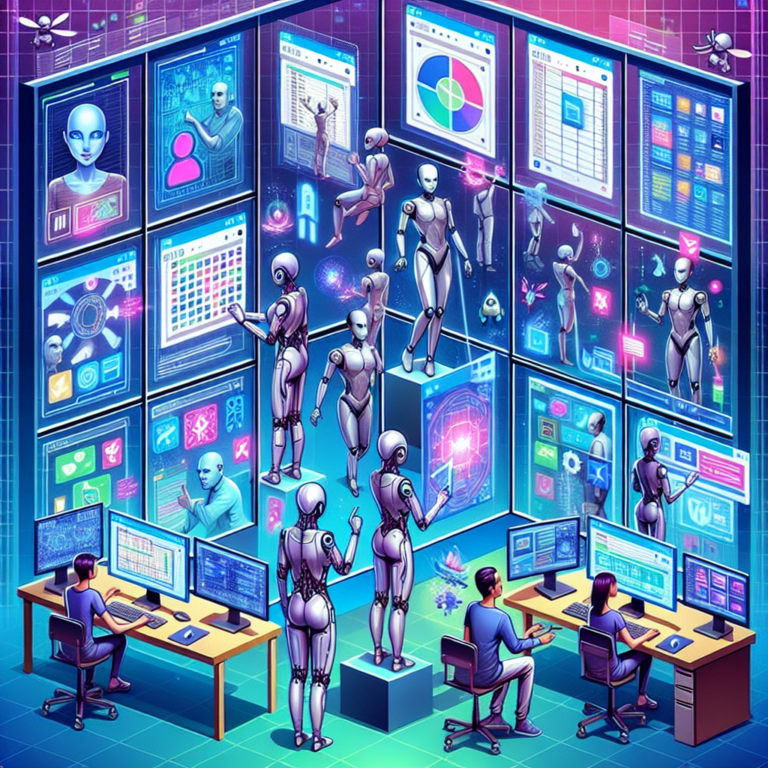Revolutionize AI Automation with Pig API’s Virtual Desktop for Windows Applications
In the evolving realm of AI automation, businesses encounter numerous challenges, particularly when trying to incorporate modern tools with older systems. Many organizations cling to outdated applications that often lack the necessary application programming interfaces (APIs) essential for effective integration. Surprisingly, more than 66% of companies still depend on these legacy systems for their core operations, leading to increased maintenance costs and heightened security vulnerabilities.
However, innovative tools like Pig API provide a transformative solution to these issues. By enabling AI agents to connect directly with graphical user interfaces (GUIs) on cloud-hosted virtual Windows desktops, Pig API effectively links advanced AI capabilities with legacy software. This integration facilitates task automation, including data entry and workflow management, without the need for extensive local infrastructure.
Breaking Down the Challenges of Legacy Systems
Conventional robotic process automation (RPA) tools such as UiPath and Automation Anywhere excel at automating repetitive tasks by mimicking human interactions with software and applications. Yet, these platforms struggle significantly when interfacing with legacy systems that heavily rely on GUI interactions and lack modern integration capabilities.
Legacy systems often do not have user-friendly APIs, resulting in burdensome and error-prone integration processes. Moreover, traditional RPA solutions often adhere to rigid rules, making it difficult to adapt to changing user interfaces or workflows. This inflexibility results in fragile automation processes requiring constant updates and maintenance.
In contrast, AI agents powered by Pig API offer a more adaptable and intelligent approach to automation. Unlike traditional RPA tools, these AI agents are not confined by strict rules; they can learn and evolve with the user interface changes. This increased adaptability reduces maintenance demands while allowing for more intricate task automation. Additionally, by operating within virtual environments, these AI agents can adeptly manage various tasks across different systems without the limitations of physical hardware.
Diving Deeper into Pig API’s GUI Automation Features
Pig API’s primary advantage lies in facilitating AI agents’ direct interaction with GUIs in cloud-hosted virtual Windows desktops. The platform’s Python software development kit (SDK) allows developers to seamlessly incorporate virtual environments into their workflows, automating processes that typically require human intervention.
Linking AI Agents to Cloud-Hosted Virtual Desktops
The main function of Pig API is to create and manage virtual machines (VMs) for AI agents, which eliminates the need for local infrastructure and enables efficient workflow scaling. Developers can easily initialize a VM, connect to it, and assign tasks for their AI agents—all through a streamlined process.
Pig API offers a specialized environment where AI agents can perform various actions, such as:
- Interacting with desktop applications
- Simulating user inputs
- Automating complex workflows
This simplification of intricate GUI interactions guarantees that developers, regardless of skill level, can effectively leverage Pig’s capabilities.
Mimicking Human-Like Interactions
Pig API allows AI agents to perform numerous actions that closely replicate human behavior. These functionalities include moving the mouse, clicking and dragging, entering data into forms or spreadsheets, and even capturing screenshots of the active desktop view. Such capabilities enable agents to make informed decisions and execute elaborate workflows during their operations.
Leveraging LLMs for Advanced Multi-Step Workflows
A standout feature of Pig API lies in its ability to integrate with large language models (LLMs) such as Anthropic’s Claude or OpenAI’s GPT. This capability empowers AI agents to make decisions within their automation workflows, enabling them to handle tasks that extend beyond simple, predefined steps. For instance, consider an AI agent tasked with:
- Launching a web browser
- Navigating to a specific website
- Extracting relevant customer feedback
- Inputting this data into an Excel spreadsheet
By utilizing LLMs, Pig API allows agents to execute multi-step tasks that combine GUI automation with AI-enhanced logic, showcasing its potential for optimizing complex operations.
Pig API’s Contribution to the Automation Ecosystem
The automation sphere is filled with diverse tools designed for a variety of scenarios, spanning from traditional RPA platforms to more sophisticated AI-driven solutions. While systems like UiPath and AutoHotkey excel in automating structured workflows, they often struggle with unstructured processes or GUI-intensive environments.
Pig API emerges as an innovative solution for situations where traditional automation tools encounter challenges, particularly when interfacing with legacy Windows applications. Other emerging solutions, including Microsoft’s UFO project and Anthropic’s Computer Use, also aim to elevate automation capabilities through intelligent agents that engage with GUIs. Yet, these technologies remain in the experimental stage and mainly focus on enhancing individual productivity rather than optimizing extensive enterprise workflows.
The Promising Future of Pig API and AI Automation
As companies navigate the complexities of integrating modern AI technologies with legacy systems, solutions like Pig API are forging new pathways. By enabling AI agents to directly engage with GUIs in virtual Windows desktops, Pig API unlocks exciting opportunities for automation in environments previously resistant to modernization. Its cloud-hosted framework and ability to operate without traditional APIs make it a valuable tool for organizations eager to extend the lifespan of legacy systems while enhancing operational efficiency.
Although Pig presents a promising avenue for GUI-based automation, it is not the sole contender in this burgeoning field. Its long-term effectiveness will depend on continuous development, clear security and compliance protocols, and the seamless integration into broader enterprise workflows. For organizations pursuing AI-driven automation solutions, Pig API represents an attractive choice, especially for sectors reliant on outdated yet vital software systems.




0 Comments